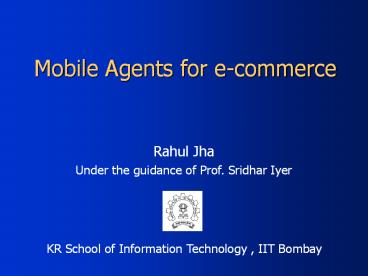Mobile Agents for e-commerce - PowerPoint PPT Presentation
Title:
Mobile Agents for e-commerce
Description:
MA advantages. reduce network usage. faster response times ... Reducing network load. Support for disconnected operation. Introduce concurrency of operations ... – PowerPoint PPT presentation
Number of Views:23
Avg rating:3.0/5.0
Title: Mobile Agents for e-commerce
1
Mobile Agents for e-commerce
- Rahul Jha
- Under the guidance of Prof. Sridhar Iyer
KR School of Information Technology , IIT Bombay
2
Overview
- Mobile Agent applications in e-commerce
- Mobility Patterns and implementation strategies
- Quantitative performance evaluation of Voyager
- Evaluation of Voyager, Aglets and Concordia
- Our Prototype of e-commerce application using
mobile agents
3
e-commerce applications
- Involve
- Product search
- Order Placement and confirmations
- Negotiations
- Characterized by
- Large amount of data exchange
- Client specific services
- Require
- Real time interactions
- Disconnected (or low bandwidth) shopping
4
Mobile Agent advantages
- Mobile agents (MA)
- A mobile agent is a program that can
autonomously migrate between the various nodes of
a network and perform computations on behalf of
the user - MA advantages
- reduce network usage
- faster response times
- add client-specified functionality to servers
- increase asynchrony between clients and servers
- introduce concurrency
5
Mobility patterns and Implementation strategies
6
Implementation strategies
2
3
C
Client
2
3
4
5
6
1
1
4
Server
C
C
Mobile Agent
(a) Sequential Client Server
(b) Sequential Mobile Agent
Message exchange
Numbers along the arrows indicate the sequence of
messages./ MA movement.
1 2 3 4 5 6
2
2
2
1
1
2
2
2
1
1
1
1
C
C
(c) Parallel Client Server
(d) Parallel Mobile Agent
7
Mobility Pattern Parameters
- Definitions
- Itinerary the set of sites that an MA has to
visit - static
- dynamic
- Order the order in which an MA visits sites in
its itinerary. - static
- dynamic
8
Static Itinerary Static Order
H1
H2
H3
H4
H1
H2
H3
H4
Order
Itinerary
C
H1
H2
H3
H4
- Sequential CS
- Sequential MA
- Parallel CS
- Parallel MA
Applicable Implementation Strategies
9
Static Itinerary Dynamic Order
?
H1
H2
H3
H4
H1
Order
Itinerary
C
H1
H2
H3
H4
- Sequential CS
- Sequential MA
- Parallel CS
- Parallel MA
Applicable Implementation Strategies
10
Dynamic Itinerary
?
?
H1
H1
Order
Itinerary
C
H1
H2
H3
H4
- Sequential CS
- Sequential MA
- Parallel CS
- Parallel MA
Applicable Implementation Strategies
11
Experimentation and results
- The e-commerce application
- A single client searching for information about a
particular product from the catalog of several
on-line stores - We assume that the client requires a highly
customized search which the on-line store does
not support.
12
Experimentation
- Experimental setup
- Voyager Framework for MA implementations
- Java socket based implementation for client
server interaction - On Pentium-III, 450 MHz workstations connected
through a 10 Mbps LAN with typical student load
13
Parameters
14
Performance metric User Turnaround Time
- time elapsed between
- a user initiating a request and receiving the
results. - equals time taken for
- agent creation
- visit / collect catalogs
- processing time to extract information.
15
Effect of catalog size on Turnaround Time
16
processing 20ms
17
processing 500ms
18
processing 1000ms
19
Observations
- Mobility patterns determine the implementation
strategies - Sequential CS most suitable where
- a small amount of information has to be retrieved
from few remote information sources. - Parallel implementations effective when
- processing information contributes significantly
to the turnaround time.
20
Observations
- Mobile agents out perform traditional approaches
when - When the cost of shipping MAs lt message exchange
size. - MAs scale effectively across the parameters of
E-commerce application
21
Evaluation of Voyager, Aglets and Concordia
22
Qualitative Comparison
23
Quantitative Evaluation Experiments
- Mobility pattern Product discovery
- Experimental setup Same as that for previous
experiments. - Performance metric User turnaround time
24
Cost of message exchange
Number
25
Cost of code shipment
26
Observations
- Voyager supports almost the super set of
functionalities and features as compared to
Aglets and Concordia. - Voyager being an ORB has advanced messaging
support and hence performs much better than
Aglets and Concordia. - Cost of code shipment for Voyager is more than
Concordia (both user RMI) - Voyager is an ORB with mobility support
- Large set of functionalities supported by Voyager
27
Our Prototype of e-commerce application using
mobile agents
28
Architecture of Our Prototype Model
29
Interaction among Components
30
(No Transcript)
31
Conclusion
- Helps user with tedious repetitive job and time
consuming activities. - Faster and real time interacting at shops
- Reducing network load
- Support for disconnected operation.
- Introduce concurrency of operations
- Client specific functionalities at the shops
32
Thank You

